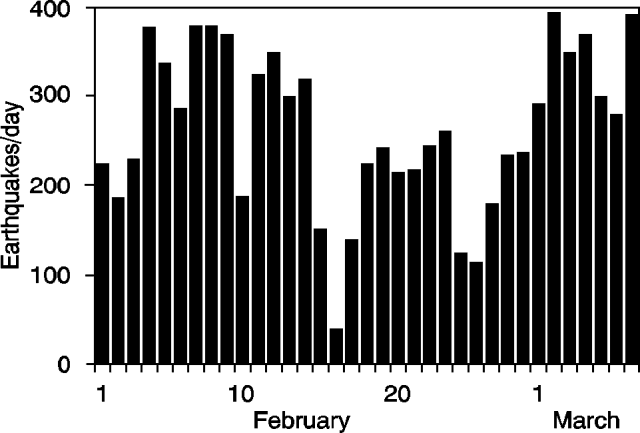Report on Poas (Costa Rica) — February 1991
Bulletin of the Global Volcanism Network, vol. 16, no. 2 (February 1991)
Managing Editor: Lindsay McClelland.
Poas (Costa Rica) Phreatic eruptions resume from lake floor; frequent earthquakes and tremor
Please cite this report as:
Global Volcanism Program, 1991. Report on Poas (Costa Rica) (McClelland, L., ed.). Bulletin of the Global Volcanism Network, 16:2. Smithsonian Institution. https://doi.org/10.5479/si.GVP.BGVN199102-345040
Poas
Costa Rica
10.2°N, 84.233°W; summit elev. 2697 m
All times are local (unless otherwise noted)
On 6 March, phreatic eruptions of mud and water, last reported 8 May 1990, resumed. The ejections reached an average height of 10 m and appeared to be a nearly continuous fountain of material when observed 11 March. Crater lake level continued to drop during February (the maximum lake depth was estimated to be 3 m on 13 February). The average lake water temperature was 70°C, similar to values from December and January. Mud pots and fumaroles were visible on the edges and within the lake, the strongest producing "jet engine" sounds. Dome fumarole temperatures of 40-90°C were measured.
SO2 fluxes averaging 90 ± 30 (1 ) t/d, with a range of 50-160 t/d, were measured by COSPEC on 13 February. These values are similar to SO2 fluxes measured in late 1982. Residents on the SW and S flanks of the volcano reported sulfur odors.
ICE recorded 4353 microearthquakes 1-26 February (an average of 162 events/day; figure 36). Univ Nacional recorded a daily average of 246 earthquakes in February, most with low frequencies (1.5-2.5 Hz). The daily total increased to an average of 323 events during the first 7 days of March. The month's largest local earthquake (M 2.1) occurred on 11 February, 3.4 km E of the crater, at a depth of 18.4 km. A total of 29 hours of low-frequency tremor (the most since October 1990) was recorded in February.
 |
Figure 36. Daily number of earthquakes at Poás, 1 February-7 March 1991. Courtesy of Rafael Barquero and Mario Fernández. |
Further Reference. Andres, R.J., Barquero, J., and Rose, W.I., 1992, New measurements of SO2 flux at Poás volcano, Costa Rica: Journal of Volcanology and Geothermal Research, v. 49, p. 175-177.
Geological Summary. The broad vegetated edifice of Poás, one of the most active volcanoes of Costa Rica, contains three craters along a N-S line. The frequently visited multi-hued summit crater lakes of the basaltic-to-dacitic volcano are easily accessible by vehicle from the nearby capital city of San José. A N-S-trending fissure cutting the complex stratovolcano extends to the lower N flank, where it has produced the Congo stratovolcano and several lake-filled maars. The southernmost of the two summit crater lakes, Botos, last erupted about 7,500 years ago. The more prominent geothermally heated northern lake, Laguna Caliente, is one of the world's most acidic natural lakes, with a pH of near zero. It has been the site of frequent phreatic and phreatomagmatic eruptions since an eruption was reported in 1828. Eruptions often include geyser-like ejections of crater-lake water.
Information Contacts: J. Barquero, OVSICORI; R. Barquero, ICE; M. Fernández, UCR; R.J. Andres and K. Kogler, Michigan Technological Univ, USA.

